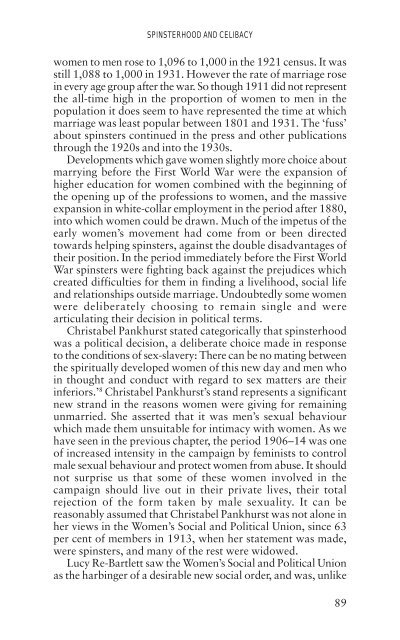The Spinster and Her Enemies - Feminish
The Spinster and Her Enemies - Feminish
The Spinster and Her Enemies - Feminish
You also want an ePaper? Increase the reach of your titles
YUMPU automatically turns print PDFs into web optimized ePapers that Google loves.
SPINSTERHOOD AND CELIBACY<br />
women to men rose to 1,096 to 1,000 in the 1921 census. It was<br />
still 1,088 to 1,000 in 1931. However the rate of marriage rose<br />
in every age group after the war. So though 1911 did not represent<br />
the all-time high in the proportion of women to men in the<br />
population it does seem to have represented the time at which<br />
marriage was least popular between 1801 <strong>and</strong> 1931. <strong>The</strong> ‘fuss’<br />
about spinsters continued in the press <strong>and</strong> other publications<br />
through the 1920s <strong>and</strong> into the 1930s.<br />
Developments which gave women slightly more choice about<br />
marrying before the First World War were the expansion of<br />
higher education for women combined with the beginning of<br />
the opening up of the professions to women, <strong>and</strong> the massive<br />
expansion in white-collar employment in the period after 1880,<br />
into which women could be drawn. Much of the impetus of the<br />
early women’s movement had come from or been directed<br />
towards helping spinsters, against the double disadvantages of<br />
their position. In the period immediately before the First World<br />
War spinsters were fighting back against the prejudices which<br />
created difficulties for them in finding a livelihood, social life<br />
<strong>and</strong> relationships outside marriage. Undoubtedly some women<br />
were deliberately choosing to remain single <strong>and</strong> were<br />
articulating their decision in political terms.<br />
Christabel Pankhurst stated categorically that spinsterhood<br />
was a political decision, a deliberate choice made in response<br />
to the conditions of sex-slavery: <strong>The</strong>re can be no mating between<br />
the spiritually developed women of this new day <strong>and</strong> men who<br />
in thought <strong>and</strong> conduct with regard to sex matters are their<br />
inferiors.’ 8 Christabel Pankhurst’s st<strong>and</strong> represents a significant<br />
new str<strong>and</strong> in the reasons women were giving for remaining<br />
unmarried. She asserted that it was men’s sexual behaviour<br />
which made them unsuitable for intimacy with women. As we<br />
have seen in the previous chapter, the period 1906–14 was one<br />
of increased intensity in the campaign by feminists to control<br />
male sexual behaviour <strong>and</strong> protect women from abuse. It should<br />
not surprise us that some of these women involved in the<br />
campaign should live out in their private lives, their total<br />
rejection of the form taken by male sexuality. It can be<br />
reasonably assumed that Christabel Pankhurst was not alone in<br />
her views in the Women’s Social <strong>and</strong> Political Union, since 63<br />
per cent of members in 1913, when her statement was made,<br />
were spinsters, <strong>and</strong> many of the rest were widowed.<br />
Lucy Re-Bartlett saw the Women’s Social <strong>and</strong> Political Union<br />
as the harbinger of a desirable new social order, <strong>and</strong> was, unlike<br />
89

















